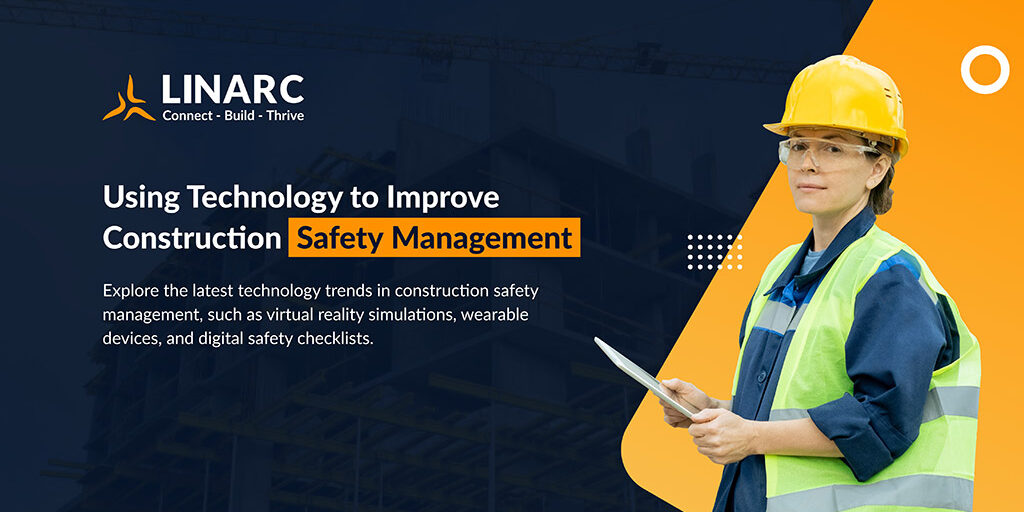Using Technology to Improve Construction Safety Management

This article covers:
Harnessing the Benefits of Technology for Construction Management
Adopting new strategies and new practices can help construction companies remain competitive in the marketplace. According to McKinsey, “The pandemic has dramatically increased the speed at which digital is fundamentally changing business.” We’ve seen the rate of adoption of digital technologies accelerated by several years. Utilizing technology in construction safety management is on the rise too and aligns well with the growing workforce of tech-savvy construction workers.
Types of Technology in Construction Site Safety Management
Employing technology in the field can take many forms. From wearable devices on workers to apps on mobile devices, there are several ways technical innovations are supporting construction safety management today.
1. Wearable Devices
Wearable devices may sound unfamiliar, but in simple terms these can include the increasingly common smartwatches or smart rings. In 2022, there were a reported 216.43 million smartwatch users with a prediction of 224.27 million smartwatch users by the end of the year 2023.
These devices can generate real-time physiological measurements, such as heart rate and blood pressure, as well as track posture and movement using sensors or cameras. By analyzing this data, construction site managers can proactively identify worker fatigue and predict potential hazards. For example, if a worker’s heart rate and posture indicate fatigue, they could be alerted to take a break or switch to a less physically demanding task. This type of data-driven approach can significantly improve construction site safety.
2. Drones
Drones offer an aerial perspective not offered from the ground. In construction, drones assist in safer inspections by reducing the risk of injury by trying to navigate hard-to-reach spots. In addition, the use of drones can efficiently identify the position of workers and equipment. These eyes in the sky allow crews to work safely together.

3. Virtual and Augmented Reality
OSHA estimates that construction companies save $4 to $6 for every $1 invested in safety programs. Safety training for construction workers has come a long way from flipping through 3-ring binders full of safety protocols at all-day seminars in cold, hotel conference rooms. The use of virtual and augmented reality in construction safety training programs simulates hazards and dangerous scenarios. Workers can experience them and practice safety protocols without being in physical harm.
4. Construction Safety Management Software
Digital transformation in the construction industry includes the use of software and engaging with digital content. With the support of construction management software, safety drills, safety huddles and safety checklists can be set up within the schedule. The National Association of Safety Professionals (NASP) reports that 60% of construction accidents occur within an employee’s first year on the job. Being proactive with safety huddles enhance site awareness and communication, proactively flag safety concerns, reinforce safety protocols and increase accountability across the jobsite.
Eliminate excuses and reduce safety issues when safety checklists and reminders are at construction workers’ fingertips. Safety protocols can be worked into assigned tasks. From the jobsite, workers can access pre-filtered safety content relevant to their field of work. Furthermore, they can document work environments by taking a picture on their phone and uploading it to the software.
Safety directors and upper management gain a line of sight into the validity of safety measures on the jobsite with construction management software. They can easily sync with the field to know if daily huddles are happening and checklists are being followed. Real-time access and reporting, plus mobile capture of audio and visuals confirm onsite safety compliance.
5. GPS
Most people rely on GPS to meet friends at a new restaurant or navigate a new city. Regarding construction safety management, GPS can make a difference in crisis situations. Unfortunately, accidents do happen. When they do, having the means to respond quickly and efficiently is the difference between life and death. Having construction workers equipped with GPS-enabled devices can help emergency responders locate accidents and injured workers.
6. Sensors
Sensors exist in many places that we don’t even think of to keep us safe on a daily basis. On a construction site, sensors are utilized to detect hazards such as gas leaks or other harmful chemicals. Some machinery and tools have sensors that capture data for preventative and predictive maintenance. Based on historical data, operators are notified of wear and tear or other maintenance issues that need attention. Without the alerts, workers run the risk of an equipment breakdown that can directly or indirectly cause an accident.
Using Data Analytics to Advance Construction Site Safety
Integrating data analytics into construction safety monitoring and management offers an ongoing feedback loop for continuous improvement and a proactive approach to construction site safety. Determine the effectiveness of safety measures and initiatives through reporting and dashboards such as Linarc’s advanced construction management solution. Key personnel can tell what is working and not working to ensure everyone on the jobsite is safe and compliant.
Construction Management Software with Safety Built In
The Linarc cloud-based, construction project management system is designed for safety, quality, and performance.
Linarc is built solely for collaborative, data-driven construction management with:
- Seamless collaboration
- Easy file sharing
- Common communication platform
- Real-time updates on project progress
- …and so much more
Connect with a Linarc representative and see what the power of technology can do to improve the safety of your operation.
Connect – Build – Thrive with Linarc construction management software.




